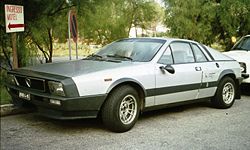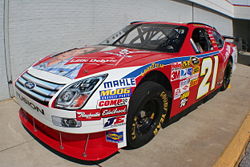
Silhouette racing car
Encyclopedia



Production vehicle
A production vehicle is one that is put into mass production, as a model produced in large numbers and offered for sale to the public. It is the vehicle you can actually go out and buy ....
, differs mechanically in fundamental ways. The purpose of silhouette cars is to provide a manufacturer with a tangible link to their consumer product offering so as to derive maximum marketing benefit from their investment in the sport. They also provide spectators with familiar car models with which they can identify.
Entire championship fields can consist of silhouettes, or sometimes only a single class in a multi-class field may permit silhouettes. Notable racing classes where silhouette cars have been used include NASCAR
NASCAR
The National Association for Stock Car Auto Racing is a family-owned and -operated business venture that sanctions and governs multiple auto racing sports events. It was founded by Bill France Sr. in 1947–48. As of 2009, the CEO for the company is Brian France, grandson of the late Bill France Sr...
, Group 5 Special Production Cars
Group 5 (racing)
Group 5 was an FIA motor racing classification which was applied to four distinct categories during the years 1966 to 1982. Initially Group 5 regulations defined a Special Touring Car category and from 1970 to 1971 the classification was applied to limited production Sports Cars restricted to 5...
, Group B rallying
Group B
Group B was a set of regulations introduced in 1982 for competition vehicles in sportscar racing and rallying regulated by the FIA. The Group B regulations fostered some of the quickest, most powerful and sophisticated rally cars ever built. However, a series of major accidents, some fatal, were...
and DTM
Deutsche Tourenwagen Masters
The Deutsche Tourenwagen Masters is a touring car racing series based in Germany, but also with rounds elsewhere in Europe....
.
Silhouette cars often employ radically different chassis construction techniques such as tubular space frames
Space frame
A space frame or space structure is a truss-like, lightweight rigid structure constructed from interlocking struts in a geometric pattern. Space frames can be used to span large areas with few interior supports...
or carbon fibre tubs in place of regular monocoques, and many also have completely different drivetrain
Powertrain
In a motor vehicle, the term powertrain or powerplant refers to the group of components that generate power and deliver it to the road surface, water, or air. This includes the engine, transmission, drive shafts, differentials, and the final drive...
configurations than their road-going counterparts. The bodyshells
Coachwork
Coachwork is the body of a horse-drawn coach or carriage, a motor vehicle , a railroad car or railway carriage. Usually reserved for bodies built on a separate chassis, rather than being of unitary or monocoque construction...
themselves are generally made of lightweight materials such as glass-reinforced plastic
Glass-reinforced plastic
Fiberglass , is a fiber reinforced polymer made of a plastic matrix reinforced by fine fibers of glass. It is also known as GFK ....
or carbon fibre and often few or no parts are shared between race and road versions of the cars. These changes are aimed at improving the desirable characteristics of the components, such as increasing the stiffness of the chassis, or the output of the engine.
Due to homologation rules (e.g. Group B rally cars
Group B
Group B was a set of regulations introduced in 1982 for competition vehicles in sportscar racing and rallying regulated by the FIA. The Group B regulations fostered some of the quickest, most powerful and sophisticated rally cars ever built. However, a series of major accidents, some fatal, were...
), some silhouette racing cars, such as the Lancia 037
Lancia 037
The Lancia Rally 037 was a mid-engine rally car built by Lancia in the early 1980s purely for the FIA Group B World Rally Championship. Driven by Markku Alén, Attilio Bettega, and Walter Röhrl, the car won Lancia the manufacturers' world championship in the 1983 season...
and Lancia Delta S4
Lancia Delta S4
The Lancia Delta S4 is a Group B rally car that competed in the World Rally Championship in 1985 and 1986, until Group B cars were banned from competition by the FIA. The car replaced and was an evolution of the Lancia 037 Monte Carlo. The S4 took full advantage of the Group B regulations, and...
, also end up being sold as road cars.

